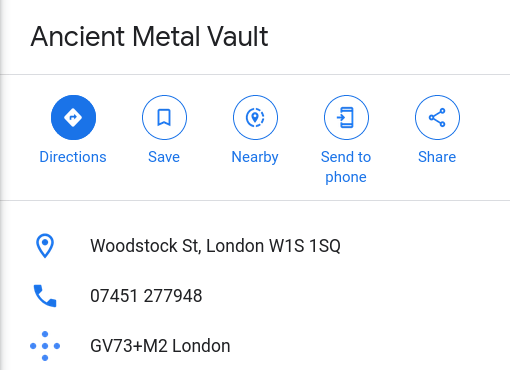A weird (trap?) artefact in Google Maps
Cartographers occasionally sneak deliberate mistakes into their maps. Known as trap streets they are a simple "copyright trap". If someone copies their map without permission, the fake street shows evidence of the source of plagiarism.
Google do this sometimes. They once proclaimed that Argleton was a real place - despite its non-existence.
While I was looking for something to do in London recently, I came across this curious entry.
 Why does Google think there is an "Ancient Metal Vault" in Mayfair?
Why does Google think there is an "Ancient Metal Vault" in Mayfair?
There's nothing similar on OpenStreetMap. Similarly Bing and Ordnance Survey show nothing there.
I thought it might be a historic place - but there are no search results for it.
What does Google Maps say about the place?

Nothing. Except a UK mobile phone number. When I called, I got an American "This number is not in service" message.
If it were a dozen years ago, I'd've thought this was the start of some augmented reality game. But, instead, I think it's most likely an artefact from some old mapping data they've imported.
Either that, or it is time to go digging up some London streets in the dead of night for an exciting caper!
Mike Nolan says:
https://twitter.com/MikeNolan/status/145076409344339969
I got a UK message saying not recognised - I assume it depends on the provider you're phoning from.
| Reply to original comment on coldrick.me.uk
Paper Towns - Wikipedia
| Reply to original comment on mstdn.social
Richard says:
The accused company was adamant they had done their own survey, however, and that this really was the name of the place.
A site visit was organised to settle the matter. The first company was astonished to find a corner shop with their made up name on the exact spot in question. They went inside and asked the owner to explain.
The owner produced a copy of the original firm’s map, pointed to his shop, and said they just named it for the place it was in…
| Reply to original comment on mastodon.me.uk
More comments on Mastodon.